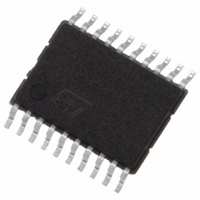STPM11ATR STMicroelectronics, STPM11ATR Datasheet - Page 30

STPM11ATR
Manufacturer Part Number
STPM11ATR
Description
IC ENERGY METER 1 PHASE 20TSSOP
Manufacturer
STMicroelectronics
Datasheet
1.STPM13ATR.pdf
(46 pages)
Specifications of STPM11ATR
Input Impedance
100 KOhm
Measurement Error
0.1%
Voltage - I/o High
1.5V
Voltage - I/o Low
0.8V
Current - Supply
4.7mA
Voltage - Supply
3 V ~ 5.5 V
Operating Temperature
-40°C ~ 85°C
Mounting Type
Surface Mount
Package / Case
20-TSSOP
Meter Type
Single Phase
Output Voltage
+/- 0.4 V
Output Current
150 mA
Input Voltage
3 V to 5.5 V
Operating Temperature Range
- 40 C to + 85 C
Mounting Style
SMD/SMT
Lead Free Status / RoHS Status
Lead free / RoHS Compliant
Other names
497-5984-2
Theory of operation
7.16
Table 16.
7.17
30/46
Signal
PUMP
Name
WE
RD
Value
Mode signals
The STPM1x includes four mode signals. These signals change some of the operation of
the STPM1x. The mode signals are not retained when the STPM1x supply is not available
and then they are cleared when a POR occurs.
The mode signals bit can be written using the normal writing procedure of the CFGI
interface (see CFGI par. 7.17)
Mode signals description
CFGI: configuration interface
The CFGI interface supports a simple serial protocol, which is implemented in order to
enable the configuration of STPM1x which allows writing the mode bits and the
configuration bits (temporarily or permanently);
Four pins of the device are dedicated to this purpose: SCS, SYN-NP, SCLNCN, SDATD.
SCS, SYN-NP, SCL-NLC and SDATD are all input pins. A high level signal for these pins
means a voltage level higher than 0.75 x V
lower than 0.25 x V
Bit
0
1
0
1
0
1
– RD mode signal has been already described in par.
– PUMP. When set, the PUMP mode signal transforms the MOP and MON pins to act
– WE (write Enable): This mode signal is used to permanently write to the OTP anti-
but there is another implied function of the signal RD. When it is set, each sense
amplifier is disconnected from corresponding antifuse element and this way, its 3 V
NMOS gate is protected from the high voltage of V
operation. This means that as long as the V
signal RD should be set.
as driving signals to implement a charge-pump DC-DC converter (see
This feature is useful in order to boost the V
generate the V
elements.
fuse element. When this bit is not set, any writing to the configuration bit is recorded
in the shadow latches. When this bit is set, the writing is recorded both in the shadow
latch and in the OTP anti-fuse element.
MOP and MON operate normally
MOP and MON provide the driving signals to implement a
charge-pump DC-DC converter
The 56 Configuration bits originated by OTP anti-fuses
The 56 Configuration bits originated by shadow latches
Any writing in the configuration bits is recorded in the shadow
latches
Any writing in the configuration bits is recorded both in the
shadow latches and in the OTP anti-fuse elements
CC
OTP
.
voltage (14 V to 20 V) needed to program the OTP anti-fuse
Doc ID 13167 Rev 7
Status
CC
, while a low level signal means a voltage value
OTP
CC
STPM11, STPM12, STPM13, STPM14
supply voltage of the STPM1x to
voltage reads more than 3 V, the
OTP
7.15
during permanent write
(configuring the STPM1x),
Command
1111101x
0111001x
1111001x
0111101x
0111110x
1111110x
Binary
Figure
Command
FC or FD
7C or 7D
7A or 7B
FA or FB
F2 or F3
72 or 73
Hex
23).












